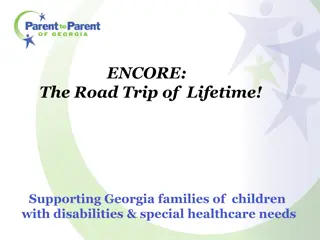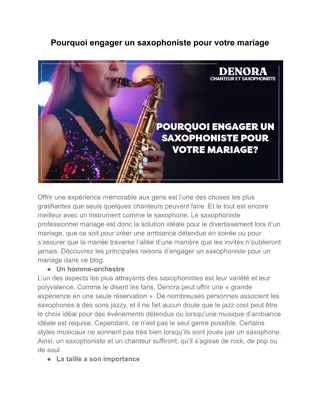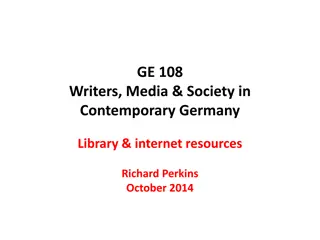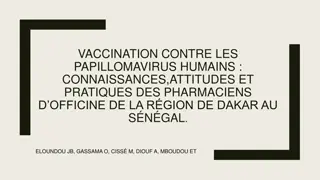
Comparison of NNRTI Medications in HIV Treatment - Study Results
Explore the differences between NNRTI medications EFV and RPV in the ECHO-THRIVE, STAR, SENSE, DOR, and DRIVE-AHEAD trials. Dive into the ENCORE1 study comparing EFV 400 mg vs. 600 mg with TDF/FTC, assessing response rates and patient outcomes. Gain insights into the effectiveness and safety of these antiretroviral therapies in ARV-naive individuals.
Download Presentation

Please find below an Image/Link to download the presentation.
The content on the website is provided AS IS for your information and personal use only. It may not be sold, licensed, or shared on other websites without obtaining consent from the author. If you encounter any issues during the download, it is possible that the publisher has removed the file from their server.
You are allowed to download the files provided on this website for personal or commercial use, subject to the condition that they are used lawfully. All files are the property of their respective owners.
The content on the website is provided AS IS for your information and personal use only. It may not be sold, licensed, or shared on other websites without obtaining consent from the author.
E N D
Presentation Transcript
Comparison of NNRTI vs NNRTI ENCORE EFV vs RPV ECHO-THRIVE STAR EFV vs ETR SENSE DOR vs EFV DRIVE-AHEAD
ENCORE1 Study: (EFV 400 mg vs 600 mg QD) + TDF/FTC Design Randomisation* 1 : 1 Double-blind W48 W96 N = 324 TDF/FTC + EFV 400 mg (2 x 200 mg pills + 1 placebo pill) QD > 16 years ARV-na ve HIV RNA > 1,000 c/mL CD4 cell count: 50-500/mm3 Creatinine clearance > 50 mL/min N = 312 TDF/FTC + EFV 600 mg (3 x 200 mg pills) QD *Randomisation was stratified by clinical site and by HIV RNA (< or > 100,000 c/mL) at screening Objective Non inferiority of EFV 400 mg at W48: % HIV RNA < 200 c/mL by modified intention to treat analysis (all randomised participants who received at least 1 dose of study drug and at least one follow-up visit), 2-sided significance level of 5%, lower margin of the 95% CI for the difference = -10%, 90% power ENCORE1 Study Group, Puls R. Lancet 2014;383:1474-82; ENCORE1 Study Group. Lancet Infect Dis 2015;15:793-802 ENCORE1
ENCORE1 Study: (EFV 400 mg vs 600 mg QD) + TDF/FTC Baseline characteristics and patient disposition EFV 400 + TDF/FTC N = 321 EFV 600 + TDF/FTC N = 309 Mean age, years Female HIV RNA (log10c/mL), median HIV RNA > 100,000 c/mL CD4 cell count (/mm3), mean CD4 < 200 per mm3 Hepatitis B / hepatitis C coinfection Discontinuation by W48 Died Withdrew consent Lost to follow-up Missed week 48 visit Discontinuation by W96 Died / withdrew / lost to follow-up, N 36 31% 4.76 33.3% 273 24% 5% / 2% 10 (3.1%) N = 2 N = 3 N = 4 N = 1 22 (7%) 5 / 9 / 8 35.8 33% 4.73 34.6% 272 26% 4% / 19% 14 (3.6%) N = 3 N = 3 N = 3 N = 5 23 (7%) 5 / 5 / 13 ENCORE1 Study Group, Puls R. Lancet 2014;383:1474-82; ENCORE1 Study Group. Lancet Infect Dis 2015;15:793-802 ENCORE1
ENCORE1 Study: (EFV 400 mg vs 600 mg QD) + TDF/FTC Response to treatment at week 48, globally and by baseline HIV RNA (< 100,000 c/mL or > 100,000 c/mL) HIV RNA < 200 c/mL EFV 400 + TDF/FTC EFV 600 + TDF/FTC HIV RNA < 50 c/mL mITT mITT ITT, NC= F Per protocol % 100 94.192.2 92.290.6 90.488.9 88.386.3 87.786.1 86.084.1 84.3 82.380.4 80.677.7 78.7 75 50 25 0 All patients Difference (95% CI) =1.8% (-2.1 ; 5.8) All patients HIV RNA < 5 log HIV RNA > 5 log HIV RNA < 5 log HIV RNA > 5 log All patients Difference (95% CI) =1.5% (-3.5 ; 6.5) HIV RNA < 5 log HIV RNA > 5 log Difference (95% CI) =1.8% (-3.7 ; 7.4) ENCORE1 Study Group, Puls R. Lancet 2014;383:1474-82 ENCORE1
ENCORE1 Study: (EFV 400 mg vs 600 mg QD) + TDF/FTC Response to treatment at week 96, globally and by baseline HIV RNA (< 100,000 c/mL or > 100,000 c/mL) HIV RNA < 200 c/mL EFV 400 + TDF/FTC EFV 600 + TDF/FTC Per protocol 94.195.6 HIV RNA < 50 c/mL mITT mITT ITT, NC= F % 94.594.8 94.395.3 100 90.0 90.6 86.387.5 86.386.7 86.386.3 83.182.1 81.778.2 75 50 25 0 All patients Difference (95% CI) : - 0.6% (- 5.2 ; 4.0) All patients HIV RNA < 5 log HIV RNA > 5 log HIV RNA < 5 log HIV RNA > 5 log All patients HIV RNA < 5 log HIV RNA > 5 log Difference (95% CI) : -0.4% (-5.8 ; 4.9) Difference (95% CI) : - 1.1% (- 4.9 ; 2.8) ENCORE1 Study Group. Lancet Infect Dis 2015;15:793-802 ENCORE1
ENCORE1 Study: (EFV 400 mg vs 600 mg QD) + TDF/FTC Mean CD4 cell counts increase at W96 + 235/mm3in the EFV 400 group + 209/mm3in the EFV 600 group (p = 0.018) No difference between groups in the mean change In CD4 cell percentage In CD8 cell counts Of total lymphocyte counts At 96 weeks, Change in DASS-21 depression, anxiety, and stress Z scores did not differ between the groups ENCORE1 Study Group. Lancet Infect Dis 2015;15:793-802 ENCORE1
ENCORE1 Study: (EFV 400 mg vs 600 mg QD) + TDF/FTC Adverse events at week 48 p EFV 400 + TDF/FTC 89.1% 72.9% 22.5% 4.1% 0.4% 23 (7.1%) N = 3 EFV 600 + TDF/FTC 88.4% 73.1% 21.5% 5.0% 0.4% 22 (7.1%) N = 4 Patients with adverse events Grade 1 Grade 2 Grade 3 Grade 4 Serious adverse events, N patients Related to study drugs Adverse events definitively or probably related to study drug, N patients Discontinuation due to drug-related adverse event Adverse events of specific interest Neuro-psychiatric CNS Psychiatric Rash Gastrointestinal Hepatotoxicity 118 (36.8%) 146 (47.2%) 0.008 N = 6 (1.9%) N = 18 (5.8%) 0.01 45% N = 231 N = 13 N = 68 N = 62 N = 1 51% N = 272 N = 12 N = 105 N = 78 N = 0 NS ENCORE1 Study Group, Puls R. Lancet 2014;383:1474-82 ENCORE1
ENCORE1 Study: (EFV 400 mg vs 600 mg QD) + TDF/FTC Other safety aspects at week 48 By week 48, discontinuation of EFV : 26 (8%) in EFV 400 vs 34 (11%) in EFV 600 Frequency of serious adverse events was similar in both groups No difference between randomised groups in quality of life, depression, anxiety and stress, and EFV-related symptoms over 48 weeks No significant differences between EFV 400 and EFV 600 in change from baseline to week 48 for most laboratory parameters, except Neutrophils Mean change in creatinine clearance : 1.29 mL/min vs 2.17 mL/min Mean alkaline phosphatase increase : + 26 vs + 33 IU/L At Week 96 Only significant between-group difference : mean change in alkaline phosphatase : + 21 vs + 27 U/L (p = 0.046) ENCORE1 Study Group, Puls R. Lancet 2014;383:1474-82; ENCORE1 Study Group. Lancet Infect Dis 2015;15:793-802 ENCORE1
ENCORE1 Study: (EFV 400 mg vs 600 mg QD) + TDF/FTC Adverse events at week 96 EFV 400 + TDF/FTC N = 321 EFV 600 + TDF/FTC N = 309 p Patients with adverse events 91% 92% ns % of AE of Grade 3 4% 5% % of AE of Grade 4 1% 1% Serious adverse events, N events (N patients) 32 (24) 48 (32) ns Related to EFV N = 2 * N = 4 ** Adverse events related to EFV (N patients) 126 (39%) 148 (48%) 0.03 Discontinuation of EFV due to drug-related adverse event N = 16 (5%) N = 34 (11%) 0.03 * Grade 3 dizziness ; possible Stevens Johnson syndrome ** Rash with fever and septic shock ; rash with labial oedema ; suicide ; attempted suicide Mean changes in fasting lipids at W96 Total cholesterol, LDL-cholesterol, HDL-cholesterol and triglyceride concentrations increased modestly, but mean changes did not differ between the groups ENCORE1 Study Group. Lancet Infect Dis 2015;15:793-802 ENCORE1
ENCORE1 Study: (EFV 400 mg vs 600 mg QD) + TDF/FTC Virologic response in patients with baseline NNRTI resistance 570 patients with baseline genotypic test : NNRTI resistance, N = 18 10 assigned EFV 400 6 suppressed at W96 (all on EFV) 4 not suppressed at W96 (3/4 on EFV, 1/4 with also baseline FTC resistance) 8 assigned EFV 600 7 suppressed at W96 (6/7 on EFV) 1 not suppressed at W96 (not on EFV) Virologic failure* EFV 400 + TDF/FTC N = 321 EFV 600 + TDF/FTC N = 309 Resistance testing available, N 10 13 NNRTI resistance, N 2 3 * 2 consecutive HIV RNA > 500 c/mL Among the 36 virologic failures, 5 had baseline NNRTI resistance and 8 were not amplifiable, 23 genotypes could be interpreted ENCORE1 Study Group. Lancet Infect Dis 2015;15:793-802 ENCORE1
ENCORE1 Study: (EFV 400 mg vs 600 mg QD) + TDF/FTC Conclusion A reduced dose of 400 mg EFV QD is non-inferior to the standard dose of 600 mg QD, when combined with TDF/FTC over 96 weeks in ART-naive adults with HIV-1 infection Overall, the frequency of adverse events did not differ and there was no evidence of difference in treatment cessation between groups However, adverse events related to the study drug were more frequent with 600 mg EFV than with 400 mg, and discontinuation due to adverse events more frequent with EFV 600 mg Quality of life, negative emotional state, and efavirenz side-effect based on specific questionnaires did not differ between EFV 600 and 400 mg QD These findings provide an opportunity to reduce the unit costs of treatment and care models that are based on EFV use (caution when used with rifampicin) ENCORE1 Study Group, Puls R. Lancet 2014;383:1474-82; ENCORE1 Study Group. Lancet Infect Dis 2015;15:793-802 ENCORE1








